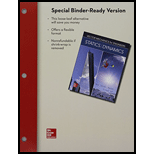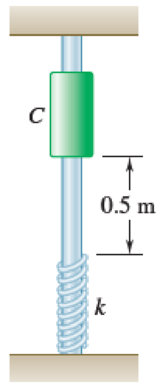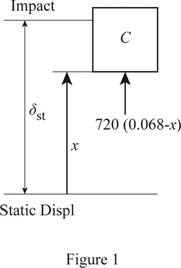
Concept explainers
A 5-kg collar C is released from rest in the position shown and slides without friction on a vertical rod until it hits a spring with a constant of k = 720 N/m that it compresses. The velocity of the collar is reduced to zero, and the collar reverses the direction of its motion and returns to its initial position. The cycle is then repeated. Determine (a) the period of the motion of the collar, (b) the velocity of the collar 0.4 s after it was released. (Note: This is a periodic motion, but it is not simple harmonic motion.)

Fig. P19.15
(a)
The period
Answer to Problem 19.15P
The period
Explanation of Solution
Given Information:
The mass (m) of the collar C is 5 kg.
The spring constant (k) is
The value of acceleration due to gravity (g) is
The vertical distance (h) between the collar and the spring is 0.5 m.
Calculation:
Calculate the natural circular frequency
Substitute
Calculate the initial velocity
Substitute
Calculate the free fall time
Substitute
Measure the displacement (x) from the position of static displacement of the spring.
Calculate the weight (W) of the collar C using the relation:
Substitute 5kg for m and
Calculate the static displacement
Substitute
Show the displacement of the collar and spring while impact as in Figure (1).

Write the equation of motion for simple harmonic motion as below:
Substitute 5 kg for m and
Write the expression for displacement (x):
Differentiate the above equation.
When time (t) is 0 the displacement (x) is equal to
Substitute 0 for t and
Rewrite the above equation,
Substitute 0 for t,
Calculate the phase angle
Substitute
Calculate the amplitude
Substitute
Hence, from time of impact, the ‘time of flight’ is the time necessary for the collar to come to rest on its downward motion. The time required for collar to rest return is
At time
Calculate the time
Substitute 0 for
Substitute
Calculate the period of motion
Substitute
Therefore, the period
(b)
The velocity
Answer to Problem 19.15P
The velocity
Explanation of Solution
Given Information:
The mass (m) of the collar C is 5 kg.
The spring constant (k) is
The value of acceleration due to gravity (g) is
The vertical distance (h) between the collar and the spring is 0.5 m.
Calculation:
Calculate the velocity
Rewrite equation (2).
Substitute
Therefore, the velocity
Want to see more full solutions like this?
Chapter 19 Solutions
VECTOR MECH...,STAT.+DYNA.(LL)-W/ACCESS
- My ID#016948724 please solve this problems and show me every step clear to follow pleasearrow_forwardMy ID# 016948724arrow_forwardPlease do not use any AI tools to solve this question. I need a fully manual, step-by-step solution with clear explanations, as if it were done by a human tutor. No AI-generated responses, please.arrow_forward
- Please do not use any AI tools to solve this question. I need a fully manual, step-by-step solution with clear explanations, as if it were done by a human tutor. No AI-generated responses, please.arrow_forwardPlease do not use any AI tools to solve this question. I need a fully manual, step-by-step solution with clear explanations, as if it were done by a human tutor. No AI-generated responses, please.arrow_forward[Q2]: The cost information supplied by the cost accountant is as follows:Sales 20,00 units, $ 10 per unitCalculate the (a/ newsale guantity and (b) new selling price to earn the sameVariable cost $ 6 per unit, Fixed Cost $ 30,000, Profit $ 50,000profit ifi) Variable cost increases by $ 2 per unitil) Fixed cost increase by $ 10,000Ili) Variable cost increase by $ 1 per unit and fixed cost reduces by $ 10,000arrow_forward
- can you please help me perform Visual Inspection and Fractography of the attatched image: Preliminary examination to identify the fracture origin, suspected fatigue striation, and corrosion evidences.arrow_forwardcan you please help[ me conduct Causal Analysis (FTA) on the scenario attatched: FTA diagram which is a fault tree analysis diagram will be used to gain an overview of the entire path of failure from root cause to the top event (i.e., the swing’s detachment) and to identify interactions between misuse, material decay and inspection errors.arrow_forwardhi can you please help me in finding the stress intensity factor using a k-calcluator for the scenario attathced in the images.arrow_forward
 Elements Of ElectromagneticsMechanical EngineeringISBN:9780190698614Author:Sadiku, Matthew N. O.Publisher:Oxford University Press
Elements Of ElectromagneticsMechanical EngineeringISBN:9780190698614Author:Sadiku, Matthew N. O.Publisher:Oxford University Press Mechanics of Materials (10th Edition)Mechanical EngineeringISBN:9780134319650Author:Russell C. HibbelerPublisher:PEARSON
Mechanics of Materials (10th Edition)Mechanical EngineeringISBN:9780134319650Author:Russell C. HibbelerPublisher:PEARSON Thermodynamics: An Engineering ApproachMechanical EngineeringISBN:9781259822674Author:Yunus A. Cengel Dr., Michael A. BolesPublisher:McGraw-Hill Education
Thermodynamics: An Engineering ApproachMechanical EngineeringISBN:9781259822674Author:Yunus A. Cengel Dr., Michael A. BolesPublisher:McGraw-Hill Education Control Systems EngineeringMechanical EngineeringISBN:9781118170519Author:Norman S. NisePublisher:WILEY
Control Systems EngineeringMechanical EngineeringISBN:9781118170519Author:Norman S. NisePublisher:WILEY Mechanics of Materials (MindTap Course List)Mechanical EngineeringISBN:9781337093347Author:Barry J. Goodno, James M. GerePublisher:Cengage Learning
Mechanics of Materials (MindTap Course List)Mechanical EngineeringISBN:9781337093347Author:Barry J. Goodno, James M. GerePublisher:Cengage Learning Engineering Mechanics: StaticsMechanical EngineeringISBN:9781118807330Author:James L. Meriam, L. G. Kraige, J. N. BoltonPublisher:WILEY
Engineering Mechanics: StaticsMechanical EngineeringISBN:9781118807330Author:James L. Meriam, L. G. Kraige, J. N. BoltonPublisher:WILEY





